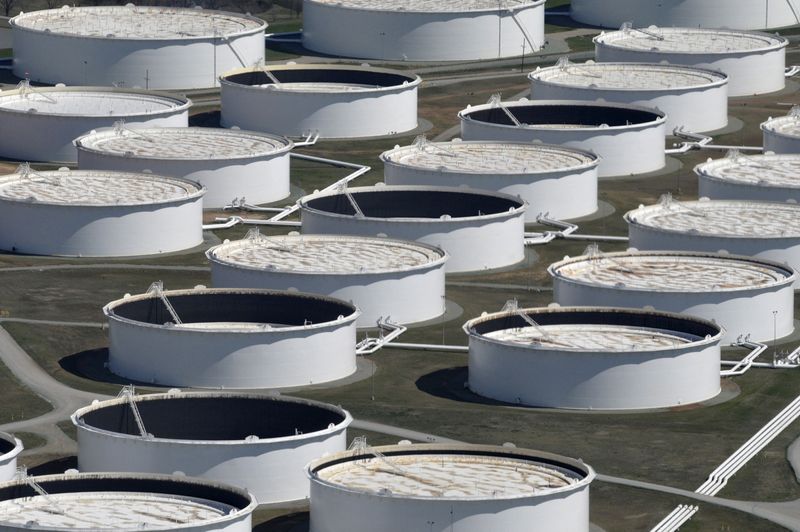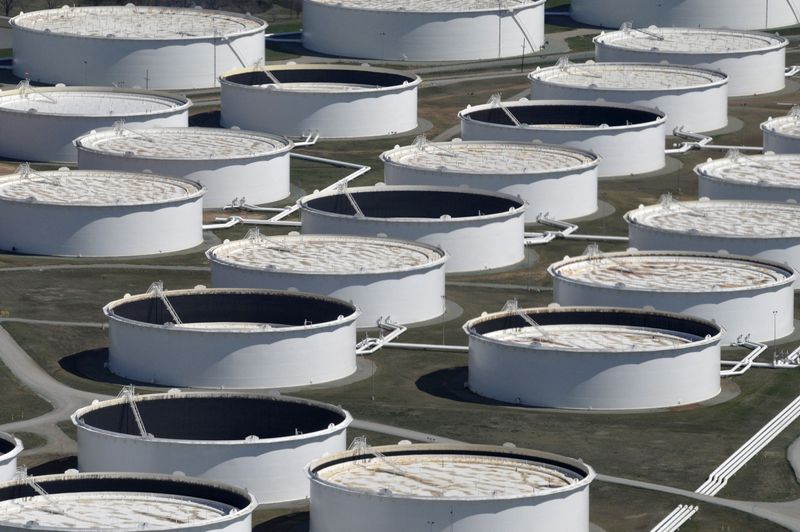Commodities
Analysis-Promise of calmer markets as US oil wrests pricing power from Brent


© Reuters. FILE PHOTO: Crude oil storage tanks are seen from above at the Cushing oil hub, appearing to run out of space to contain a historic supply glut that has hammered prices, in Cushing, Oklahoma, March 24, 2016. REUTERS/Nick Oxford//File Photo
By Alex Lawler
LONDON (Reuters) – Increased exports of oil from the United States into Europe and Asia mean has snatched back its primacy in setting international pricing after North Sea (NYSE:) grades have for decades determined the value of the world’s most traded commodity.
The trend has calmed volatility and limits the potential for trading plays, known by traders as squeezes, that have on occasions distorted the established Brent oil benchmark, based on North Sea crudes, traders and industry insiders said.
A lack of volatility and of price distortion would be positive for consumers, stung by months of high inflation driven by energy prices. Some analysts also say the change has shifted power to U.S. companies and traders in the U.S. market.
Historically, U.S. West Texas Intermediate crude futures were the first widely accessible crude contracts launched on financial markets in 1983 until the Brent futures contract, launched in 1988, eventually gained prominence.
Its rise has been checked by declining volumes from ageing North Sea fields, while U.S. production has continued to rise as a result of the shale revolution that meant oil previously too difficult to extract could be released.
As a result, oil-index publisher S&P Global Commodity Insights, widely known as Platts, added the U.S. crude grade WTI Midland to the dated Brent benchmark from June deliveries and it often plays a role in setting its value.
“The introduction of WTI Midland into the North Sea basket has fast-tracked Midland from being a domestic crude…and rendered the U.S. grade the most important in the world, well currently anyway,” John Evans of oil broker PVM said.
Dated Brent is a part of the wider Brent complex that includes physical cargoes, swaps and the Intercontinental Exchange (NYSE:) Brent futures contract. Brent is used to price over three-quarters of the world’s traded oil.
Adi Imsirovic, director at consultant Surrey Clean Energy and a veteran oil trader who has written extensively on Brent, said the amalgamation of the two international benchmarks was positive.
“Brent is working just fine,” he said. “You’ve got the two major benchmarks in the world working in synch.”
CHANGED DYNAMICS
The extra supply underpinning the benchmark has reduced volatility in the spreads between monthly futures contracts, which previously have been distorted as traders sought profits, especially when a monthly contract expired.
Oil traders, speaking on condition of anonymity because they are not authorised to speak to the press, say the much larger WTI volumes available prevent price manipulation.
A senior executive at a major oil trader said the dynamic of Brent trading had changed “dramatically”.
Data from Kpler said the volume of WTI Midland flowing to Europe reached about 1.34 million barrels per day in July, before easing in August, far more than the typical output of the five North Sea crudes used in the benchmark.
The price of dated Brent is set by the cheapest of the six crudes. An S&P Global chart provided to Reuters shows Midland having a leading role in setting the value.
At the same time, volatility in the spread between the first- and second-month Brent crude futures contracts has decreased.
Previously, many of the companies that trade the crude, from trading houses such as Glencore (OTC:) and Vitol to refiners such as Shell (LON:), regularly built big positions that could lead to unusual patterns in related physical and derivative markets.
Although the practice did not breach any regulations, disputes have arisen, including a lawsuit, settled out of court, in which oil refiner Tosco alleged trading company Arcadia had gained a monopoly position in 2000.
Asked to comment on whether the potential for trading plays had decreased, Platts said one aim of adding more oil to any benchmark was to prevent “anomalous” price rises.
“We feel that Midland’s inclusion has been able to do that,” Joel Hanley, global director, crude and fuel oil, at S&P Global Commodity Insights, said.
POWER SHIFT?
Adding WTI to Brent has also redistributed market power, some analysts say.
Companies have firewalls in place to prevent oil traders receiving price-sensitive information.
However, traders have said that when Brent was based just on North Sea crude, companies that owned stakes in producing North Sea fields or in infrastructure, were better placed to have insight into developments that could move the market, such as outages or refinery maintenance.
“Now, the marginal powerful player is a U.S. supplier who has the knowledge of production/scheduling and shipping/port issues,” said Jorge Montepeque, who during decades working at Platts developed dated Brent.
“The power shifted and this is clearly seen when American companies who were not trading the North Sea in size suddenly rushed in.”
U.S. players, such as Occidential and Phillips 66 (NYSE:) have begun offering or bidding for WTI Midland cargoes that could set the dated Brent price, trade sources said.
Other U.S. oil companies ConocoPhillips (NYSE:) and Chevron (NYSE:) might become involved, two industry sources said. Conoco and Chevron declined to comment.
Platts said it has not seen a significant rise in U.S. companies entering the market.
LESS TRANSPARENT?
Every month, producers issue a list of the North Sea cargoes for export. There is no Midland programme because, traders say, no single company – or operator – is in charge, and several terminals supply cargoes.
Some traders say this has made the market less transparent. “We will get our cargo loading dates, but we won’t see all the loading dates at the terminal,” said a trading source.
An industry source said efforts were being made to address this by creating a loading programme for WTI.
Hanley of Platts, which told Reuters in April it did not see any problems around the lack of a programme, said adding WTI Midland into the Brent complex had already added transparency.
Imsirovic, the veteran trader, said historically some market players had always held advantages over others, but he predicted the benefits of the change would become more apparent.
“We have new players in the Brent market which is surely a good thing and we’ve widened the base of people involved,” he said. “That’s going to get even wider I think, over time.”
Thomson Reuters (NYSE:) competes with Platts in providing news and data about the oil market.
Commodities
Oil prices rise; U.S. crude inventories plunge, Russia-Ukraine truce eyed
Commodities
India’s Reliance to stop buying Venezuelan oil over US tariffs, sources say
Commodities
Oil prices climb on Venezuela supply worries

 Forex3 years ago
Forex3 years agoForex Today: the dollar is gaining strength amid gloomy sentiment at the start of the Fed’s week

 Forex3 years ago
Forex3 years agoUnbiased review of Pocket Option broker

 Forex3 years ago
Forex3 years agoDollar to pound sterling exchange rate today: Pound plummeted to its lowest since 1985

 Forex3 years ago
Forex3 years agoHow is the Australian dollar doing today?

 Cryptocurrency3 years ago
Cryptocurrency3 years agoWhat happened in the crypto market – current events today

 World3 years ago
World3 years agoWhy are modern video games an art form?

 Commodities3 years ago
Commodities3 years agoCopper continues to fall in price on expectations of lower demand in China

 Economy3 years ago
Economy3 years agoCrude oil tankers double in price due to EU anti-Russian sanctions





























